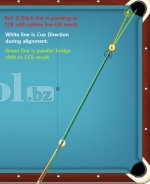I'm sure I'm not the only one here who, after aligning (setting bridge) to pot a ball, my cue is not aligned through CCB along this line.
Usually my tip is to the left of CCB by a mm or so. This is caused by a perception problem between what I see further away, focusing on the OB and peripherally estimating where my cue's aim line is relative to CCB.
If I set my bridge and just pivot to CCB during the stroke, this often leads to shooting the CB right of the line I was visualizing.
However, if I shift my bridge and hence the cue, parallel until it comes to CCB, the resultant aim line is quite close to the original line perceived.
Ideally, our fundamentals and perceptions all align perfectly, such that, when we're perceiving the line of cue to the OB, we are perfectly aligned through CCB while setting the bridge on this line.
But if we're not, this quick fix can suffice, and it can be a lot more practical than trying to fidget around getting in line with CCB while staying on the aim line, as the differences in close v distant perceptions can fight with each other such that we're not perceiving either the line to the OB or the line through CCB very clearly.
By not having to think about aligning through the CB, just pointing to the aim line with the cue, then checking where that line intersects relative to CCB, you can start to learn what shots have which tendencies, and which stances or head / eye positioning tend to bring the aim perception closer to CCB.
This diagram may make it easier to comprehend.
Usually my tip is to the left of CCB by a mm or so. This is caused by a perception problem between what I see further away, focusing on the OB and peripherally estimating where my cue's aim line is relative to CCB.
If I set my bridge and just pivot to CCB during the stroke, this often leads to shooting the CB right of the line I was visualizing.
However, if I shift my bridge and hence the cue, parallel until it comes to CCB, the resultant aim line is quite close to the original line perceived.
Ideally, our fundamentals and perceptions all align perfectly, such that, when we're perceiving the line of cue to the OB, we are perfectly aligned through CCB while setting the bridge on this line.
But if we're not, this quick fix can suffice, and it can be a lot more practical than trying to fidget around getting in line with CCB while staying on the aim line, as the differences in close v distant perceptions can fight with each other such that we're not perceiving either the line to the OB or the line through CCB very clearly.
By not having to think about aligning through the CB, just pointing to the aim line with the cue, then checking where that line intersects relative to CCB, you can start to learn what shots have which tendencies, and which stances or head / eye positioning tend to bring the aim perception closer to CCB.
This diagram may make it easier to comprehend.
Attachments
Last edited:
